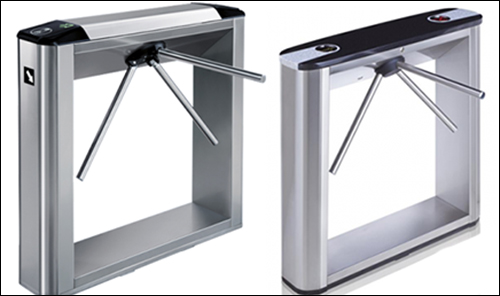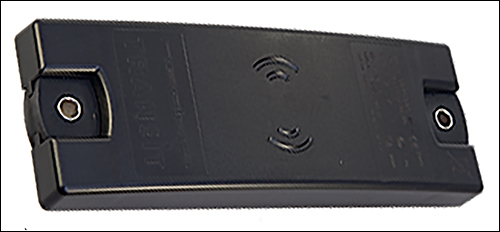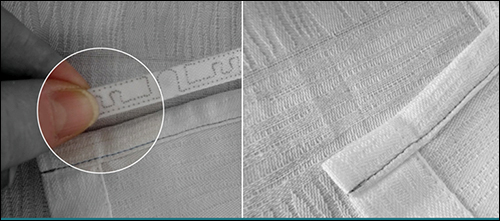The following are news announcements made during the past week by the following organizations: IDTronic; Nedap Identification Systems; Invengo Technologies; Rauland Responder, Versus Technology; Socket Mobile; and Technavio.
IDTronic Releases New Turnstile RFID Gate Readers
IDTronic has announced the availability of its ID Gate 7500 and ID Gate 8000 RFID turnstile readers.
The ID Gate 7500 is IP 44-rated, indicating that it is applicable for indoor and outdoor use. For example, the company reports, the reader is suitable for fitness studios, indoor swimming pools, waterparks, wellness resorts, theme parks and other outdoor applications.
The reader’s housing and barrier arms are made of stainless steel. The reader features an LED display on both sides that indicates status and direction. The display shows a customer where to hold his or her card or wristband to verify authorization for entry into a particular area. In addition, the turnstile reader has an extra indication of passage direction on its side posts.
The turnstile is connected to a remote panel allowing the ID Gate 7500 to be controlled from a reception area. If the turnstile receives an emergency signal, or if it is switched off, automatic folding arms come down, enabling evacuation.
The ID Gate 8000 reader features a housing of colored artificial stone and is suitable for use in wellness areas. The reader is composed of stainless steel and can be selected with optional coatings and colors.
The reader, designed for access-control applications, features LED illumination that indicates whether or not a person is authorized for entry. A green light signifies an individual is authorized, while a red stop signal indicates that the turnstile is closed and entry is denied via that location.
Nedap Announces Weatherproof, Durable RFID Tag
Nedap Identification Systems has announced its Heavy Duty Tag, a durable, weatherproof vehicle RFID tag. According to the company, the tag is suitable for applications requiring reliable, long-range identification in harsh environmental conditions.
The Heavy Duty Tag, the company reports, offers reliable performance at a distance of up to 10 meters (33 feet) with Nedap’s TRANSIT Standard reader. Features include ATEX certification for gas and dust, suitability for use in harsh environmental conditions, a tamperproof mounting, protection from shock and vibration, and an IP66-rated weatherproof enclosure. The tag is watertight, stable when exposed to high temperatures and ultraviolet rays, and resistant to shock, vibration and chemicals typical of the automotive industry.
Designed for mounting on a vehicle’s exterior, as well as on metallic parts, the tag allows for tamperproof attachment by means of bolts, screws or rivets. The tag is suitable for use in identifying trucks, trailers, containers, railway wagons, forklifts, straddle carriers and other industrial vehicles, the company reports. Compliant with the ISO 10374 RFID standard for freight containers, it fits into the corrugated pockets on the sides of freight containers, where it is automatically protected from strong impact.
The product comes with complete ATEX certification for use in potentially explosive environments. This battery-powered tag is primarily designed for use with TRANSIT Standard readers in order to achieve a long read range, but can also be read from a short distance using compatible 120 KHz readers. A built-in lithium battery has an expected lifespan of 10 years, regardless of how many times a tag is read.
Invengo Unveils Slim UHF RFID Tag for Linen Tracking
Invengo Technologies, a global RFID technology provider, has announced the launch of its latest linen tag, the LinTRAK-Slim. The company claims that the tag is the slimmest ultrahigh-frequency (UHF) RFID tag for the laundry and textile services industries.
Designed to be discreetly integrated into linen and textile products used at commercial laundries, hospitals and hotels, the LinTRAK-Slim tag is a woven label measuring 1.2 millimeters in thickness, 10 millimeters in width and 59 millimeters in length. The tag allows for rapid and seamless insertion into the hem of textile items, and is based on a patented concept that couples a small UHF device with a sewed, secondary antenna made from flexible, stainless steel thread-like material.
The LinTRAK-Slim tag integrates Impinj‘s Monza R6-P chip, an EPC Gen 2 UHF chip designed for high-volume applications. The tag has been tested by Magnetic Resonance Safety Testing Services, the company reports, and can be used safely in all types of magnetic resonance imaging (MRI) systems operating at 1.5- and 3-Tesla.
The LinTRAK-Slim is part of Invengo’s portfolio of RFID tags and stations, which includes the Acuity linen inventory visibility platform. The Acuity system is intended to provide digital analytics and services to the laundry industry, as well as to companies in the health-care and hospitality markets.
“We are particularly excited about this new tag and its innovative features that are the result of fruitful discussions with our customers and end users throughout the textile services ecosystem,” said Richard Bailly, Invengo Technologies’ president, in a prepared statement, “including linen manufacturers, laundry groups, major hotel chains and hospitals.” The LinTRAK-Slim tag is expected to be made available for orders by the end of this month.
Rauland, Versus Technology Intro Nurse-Call and RTLS Integration for Hospital Workflow Automation
Rauland Responder and Versus Technology have partnered to offer bi-directional integration between nurse-call and real-time locating system (RTLS) technologies. The new interface between the Rauland Responder All Touch and Versus RTLS solutions, the companies report, allows hospitals to share data between systems for comprehensive intelligence on workflow, health-care provider status, room condition and patient needs.
This integration automates nurse-call responses based on staff presence. The interface allows Responder All Touch to receive additional real-time information and provide Responder-related events to Versus solutions, in order to optimize room-based workflows. In the event that nursing personnel require help while out of reach of Responder 5 hardware, they can initiate a staff duress call and summon help to their exact location, by pressing their Versus RTLS badge button.
Receiving alerts from Versus Visibility Staff Assist, Responder 5 can provide a second call annunciation at the point of care and via integrated phone systems to alert key employees to the situation. This feature helps ensure that health-care providers receive the assistance they need while they are focusing on a patient’s immediate needs.
With patient location information from Versus, Responder can initiate corridor lights, whiteboards and calls to show room status. The RTLS solution determines room status (available, occupied or in need of cleaning) based on patient badge location, then forwards that information to Responder 5 via All Touch to improve bed management and facilitate quicker turnover times.
The system sends room-based notifications from Responder to Versus to enhance real-time workflow and reporting. It also shares Responder Staff Terminal event information, including EVS requests or patient milestones, to trigger notifications and workflow rules in a Versus Advantages workflow solution. A complete picture, including workflow details, is available in both Responder and Versus reports.
Socket Mobile Expands Contactless Reader-Writer Product Line
Socket Mobile, a provider of data-capture and delivery solutions, has announced the expansion of its DuraScan product line with the D600 Contactless Reader/Writer. The D600 can both read and write to Near Field Communication (NFC) tags and supports tags compliant with the ISO 15693 and ISO/IEC 14443A&B (including MIFARE & FeliCa) standards.
The D600 is the latest model in the company’s series of durable readers. As an ergonomically handheld RFID reader-writer, the D600 expands Socket Mobile’s data-capture abilities by incorporating NFC technology. Drop- and tumble-tested, the device is IP54-rated, lightweight and designed to fit in a human hand.
Cellotape, a supplier of custom printing services, including technology-driven solutions like RFID labels and NFC inlays, has been involved in the D600 device’s conceptual development. “At Cellotape, we are always looking for solutions which promote the growth of NFC and RFID inlays,” said Timothy J. Daly, Cellotape’s smart products president, in a prepared statement. “We are excited to see the D600 introduction with iOS support, excellent design and thoughtful tools. NFC applications can be migrated to Apple devices, user interfaces can be made better on Android devices, and Socket Capture makes it easier for mobile app developers to create new experiences with NFC.”
The D600 is expected to made available to developers during the second quarter of this year. General availability to consumers is slated for the third quarter.
Technavio Predicts Large RTLS Market Growth in Health Care
The global real-time location system (RTLS) market in the health-care sector is expected to grow at a rate of more than 50 percent from 2017 to 2021, according to Technavio‘s latest market research. A sample copy of the report can be requested at the company’s website.
In this market research report, Technavio covers the market outlook and growth prospects of the global RTLS market in the health-care sector for the period of 2017 to 2021. The market is categorized into three major segments based on technology, including RFID, Wi-Fi, and bar codes and QR codes. The RFID segment dominates the market, the study finds, earning more than 43 percent of the market share last year.
“The reduction in the price of RFID tags is contributing to the increase in the adoption of RTLS among hospitals that have been dependent on traditional or manual mediums for asset tracking,” said Abhishek Sharma, a lead M2M and connected devices research expert at Technavio, in a prepared statement. “The incorporation of RTLS in hospitals increases operational efficiency and improves the productivity of hospitals.”
Technavio’s ICT research analysts segmented the global RTLS market in the health-care sector market into the following regions: the Americas; Europe, the Middle East and Africa; and the Asia-Pacific region.
In the Americas, the report indicates, the United States contributes the maximum revenue to the market due to the high adoption of RFID tags and RTLS solutions throughout the country. Most U.S. hospitals are installing RTLS technologies to attain hassle-free operations, according to the study. The highest demand for RTLS in the region comes from countries such as Mexico, Canada and Brazil. It is expected that the demand for RFID tags will increase in Canada and Brazil, due to increased adoption at hospitals.
Western Europe is a prominent region in which the demand for RTLS solutions is expected to rise exponentially, the research indicates. Most demand for RTLS technologies originates in Germany, the United Kingdom and France, according to the report. Hospitals across the region use RTLS applications for asset tracking, patient safety, employee management and clinical monitoring. The increased demand for RTLS with analytical features in the health-care sector has led to the market’s growth, the study explains.
In the Middle East and Africa, RTLS technology’s penetration is very low, due to a lack of awareness about the benefits of RTLS and RFID tags among health-care and government organizations in that region. As such, the report concludes, the area offers considerable growth potential to vendors.
The Asia-Pacific region is a promising market for RTLS products, the study shows. At present, the penetration of RTLS products is low in this region. However, it is expected that there will be an upsurge in demand during the coming years. In the health-care sector, managing resources has been a prime concern. The implementation of RTLS solutions, the report notes, will help with effectively managing assets, employees and the supply chain.
“The low cost and benefits of RTLS are prompting hospitals to adopt RFID tags,” Abhishek said in the prepared statement. “Earlier, hospitals depended on traditional technologies or were managing assets manually, which is a time-consuming process.”




